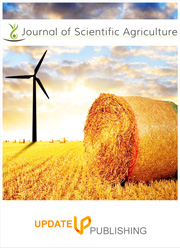Sociodemographic characterization of Cassava farmers in Cameroon
DOI:
https://doi.org/10.25081/jsa.2022.v6.9072Keywords:
Sociodemographic characterization, Cassava farmers, Food security, CameroonAbstract
The aim of this study was to profile Cameroonian cassava farmers in the Adamawa, Centre, East and South regions of Cameroon. Four (04) quantitative and ten (10) qualitative variables were analyzed using correlation analysis and Chi-square-based association testing (alpha=0.05) respectively. The results suggest that cassava farming is practiced more by women than by men. Also, the average age of cassava farmers across regions is 42.2 years. Some of Cameroon’s cassava farmers own farmland, and few have fields that are specifically devoted to Cassava cultivation due to the practice of mixed cropping and crop rotation. Moreover, the majority of Cameroonian cassava farmers consume the cassava they grow and process, and most of them are well-educated, being able to read and write, with 51% of women involved. Smartphone use is very widespread among Cassava farmers in the Centre and South regions, where the proportions between the two sexes are 26.1% (men) versus 30.3% (women), and 30.9% (men) versus 29.4% (women) respectively. The same applies to internet access. Farmers in Adamawa and the East have little access to the internet. Furthermore, very few cassava farmers belong to farmers’ organizations, and they use the income from selling the cassava they produce and process to ensure their household’s food and health security, and to send their children to school. Finally, participation in community activities is not widespread in Adamawa and the South and over the last five years, very few cassava farmers have acquired assets from the sale of cassava.
Downloads
References
Alamu, E. O., Ntawuruhunga, P., Chibwe, T., Mukuka, I., & Chiona, M. (2019). Evaluation of cassava processing and utilization at household level in Zambia. Food Security, 11(1), 141-150. https://doi.org/10.1007/s12571-018-0875-3
Bilong, E. G., Abossolo-Angue, M., Ajebesone, F. N., Anaba, B. D., Madong, B. À., Nomo, L. B., & Bilong, P. (2022). Improving soil physical properties and cassava productivity through organic manures management in the southern Cameroon. Heliyon, 8(6), e09570. https://doi.org/10.1016/j.heliyon.2022.e09570
Burns, A., Gleadow, R., Cliff, J., Zacarias, A., & Cavagnaro, T. (2010). Cassava: The Drought, War and Famine Crop in a Changing World. Sustainability, 2(11), 3572-3607. https://doi.org/10.3390/su2113572
Doungous, O., Masky, B., Levai, D. L., Bahoya, J. A. L., Minyaka, E., Mavoungou, J. F., Mutuku, J. M., & Pita, J. S. (2022). Cassava mosaic disease and its whitefly vector in Cameroon: Incidence, severity and whitefly numbers from field surveys. Crop Protection, 158, 106017. https://doi.org/10.1016/j.cropro.2022.106017
Jackson, J., Chiwona-Karltun, L., & Gordon, A. (2020). Food safety and quality considerations for cassava, a major staple containing a natural toxicant. In A. Gordon (Ed.), Food Safety and Quality Systems in Developing Countries (pp. 343-366) Cambridge, US: Academic Press. https://doi.org/10.1016/B978-0-12-814272-1.00008-5
Kolawole, P. O., Agbetoye, L., & Ogunlowo, S. A. (2010). Sustaining World Food Security with Improved Cassava Processing Technology: The Nigeria Experience. Sustainability, 2(12), 3681-3694. https://doi.org/10.3390/su2123681
Masamha, B., Thebe, V., & Uzokwe, V. N. E. (2018). Mapping cassava food value chains in Tanzania’s smallholder farming sector: The implications of intra-household gender dynamics. Journal of Rural Studies, 58, 82-92. https://doi.org/10.1016/j.jrurstud.2017.12.011
Ngongo, Y., Basuki, T., deRosari, B., Mau, Y. S., Noerwijati, K., daSilva, H., Sitorus, A., Kotta, N. R. E., Utomo, W. H., & Wisnubroto, E. I. (2022). The Roles of Cassava in Marginal Semi-Arid Farming in East Nusa Tenggara—Indonesia. Sustainability, 14(9), 5439. https://doi.org/10.3390/su14095439
Olaosebikan, O., Abdulrazaq, B., Owoade, D., Ogunade, A., Aina, O., Ilona, P., Muheebwa, A., Teeken, B., Iluebbey, P., Kulakow, P., Bakare, M., & Parkes, E. (2019). Gender-based constraints affecting biofortified cassava production, processing and marketing among men and women adopters in Oyo and Benue States, Nigeria. Physiological and Molecular Plant Pathology, 105, 17-27. https://doi.org/10.1016/j.pmpp.2018.11.007
Prudencio, Y. C., & Al-Hassan, R. (1994). The food security stabilization roles of cassava in Africa. Food Policy, 19(1), 57-64. https://doi.org/10.1016/0306-9192(94)90008-6
Tafesse, A., Mena, B., Belay, A., Aynekulu, E., Recha, J. W., Osano, P. M., Darr, D., Demissie, T. D., Endalamaw, T. B., & Solomon, D. (2021). Cassava Production Efficiency in Southern Ethiopia: The Parametric Model Analysis. Frontiers in Sustainable Food Systems, 5, 758951. https://doi.org/10.3389/fsufs.2021.758951
Teeken, B., Olaosebikan, O., Haleegoah, J., Oladejo, E., Madu, T., Bello, A., Parkes, E., Egesi, C., Kulakow, P., Kirscht, H., & Tufan, H. A. (2018). Cassava Trait Preferences of Men and Women Farmers in Nigeria: Implications for Breeding. Economic Botany, 72(3), 263-277. https://doi.org/10.1007/s12231-018-9421-7
Tize, I., Fotso, A. K., Nukenine, E. N., Masso, C., Ngome, F. A., Suh, C., Lendzemo, V. W., Nchoutnji, I., Manga, G., Parkes, E., Kulakow, P., Kouebou, C., Fiaboe, K. K. M., & Hanna, R. (2021). New cassava germplasm for food and nutritional security in Central Africa. Scientific Reports, 11(1), 7394. https://doi.org/10.1038/s41598-021-86958-w
Published
How to Cite
Issue
Section
Copyright (c) 2022 Dickmi Vaillam Claudette, Tchouamo Isaac Roger

This work is licensed under a Creative Commons Attribution-NonCommercial-NoDerivatives 4.0 International License.



 .
.